|
|

 The automobile was certainly revolutionizing life
The automobile was certainly revolutionizing life
 Ford discovers how to make cars more cheaply
Ford discovers how to make cars more cheaply
 But the new automobile culture was not without its problems
But the new automobile culture was not without its problems
 The technology of human flight
The technology of human flight
 All in all, life seemed very good
All in all, life seemed very good
The textual material on this webpage is drawn directly from my work America – The Covenant Nation © 2021, Volume One, pages 360-365. |

|
|
In the field of transportation, new ideas were
quickly being put to use to revolutionize private or personal
transportation, in the form of the "horseless carriage." Steam engines
mounted on carriages were attempted as the first automobiles, as in the
1878 200-mile (33-hour) race in Wisconsin between two such vehicles.
This steam technology used in automobiles (as in the popular Stanley
Steamer1) would continue
to develop even into the 1920s. But by that time gasoline-powered
internal combustion engines (ICEs) were beginning to rule the road. No single person was responsible for the invention of the internal combustion engine, but it was a technology developed in a vast number of ways, including even the idea of using gunpowder to fire the device. Inventors in Europe and America built on the discoveries of each other, finding new improvements to patent. In the mid-1880s, the German Karl Friedrich Benz and the Englishman Edward Butler almost simultaneously developed something like modern gas engines to power their automobiles,2 and the race was on by inventors to build varieties of this new engine. The competition included a number of American builders. By 1904 the Olds Motor Vehicle Company (founded in 1897 in Lansing and then later moved to Detroit, Michigan) was the leading mass-producer of the American automobile.3 Then when in 1913 Henry Ford introduced his mass-assembled Model T Ford (you could order it in any color, as long as it was black!) the automobile industry in America grew explosively. And eventually offered at just under $500 per car (approximately $7,000 today), the Model T put ownership of an automobile within the reach of millions of ordinary Americans. 1The Stanley twins (Francis and Freelan) were early entrants into the automotive industry, with their production of over 200 steam-powered cars, making them the largest producers in the 1898-1899 period. In 1902 they founded the Stanley Motor Carriage Company and produced the famous Stanley Steamer, an amazing vehicle which in 1906 was able to reach 127 miles per hour over a one-mile course at Daytona Beach, Florida. By 1917 their rate of production peaked at 500 cars. But Ford's gasoline-powered internal combustion engine Model T cut drastically into their market and they closed their business in 1924. 2Butler's petroleum four-stroke engine was simpler but earlier. Foolishly, British authorities passed a law restricting the speed of his vehicle (requiring a flag-bearing person to walk in front of the vehicle in order to give a safety warning to others!), and soon other requirements that stalled British development of the automobile. Benz's petroleum-fueled two-stroke engine came with a battery to fire the spark plugs, a carburetor to regulate the oxygen intake, the clutch and gear shift to engage the engine at different road speeds, and a water radiator to cool the engine, the basics of a modern automobile engine. 3No,
Henry Ford did not invent the assembly line. That honor really belonged
to the Olds Company. But Ford did perfect it by making it a moving line
of assembly.
|
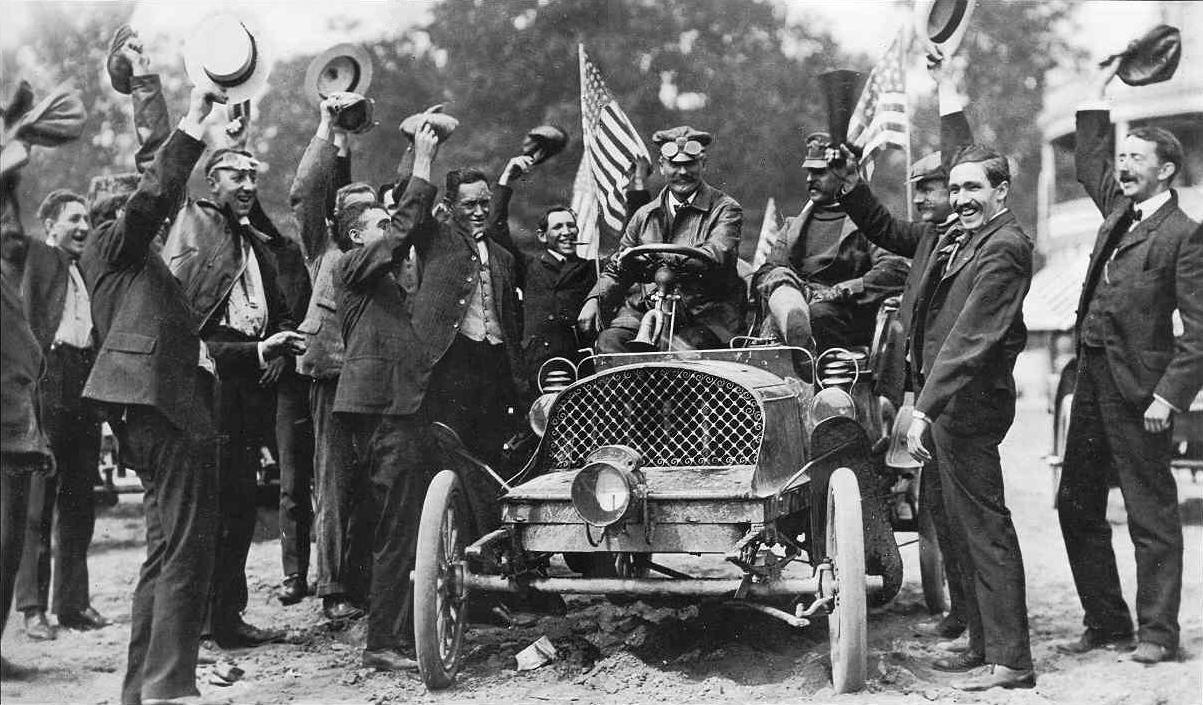
The finish of a transcontinental
auto tour – 1904
Drivers preparing for the
start of the 1909 Indianapolis 100-mile race
(the event was won by Louis Strang with
an average speed of 64 miles per hour)
A prosperous country family
in a Haynes Touring Car

|
|
Not one to be discouraged easily, he built yet another model soon after and which he raced successfully, leading his financial backers to support him in forming in 1901 yet another manufacturing company, the Henry Ford Company. But he left the company the next year (which became the Cadillac Automobile Company) to build a new eighty horsepower automobile, which Barney Oldfield raced famously to victory that same year. He now partnered up with a Detroit-area coal dealer, and he proceeded to work on developing an inexpensive model which would market well within the rapidly growing world of automobile ownership. But although financing was still tight, he secured some additional backers, and in 1903 formed the Ford Motor Company. He then had Oldfield drive his car around the country, attracting wide interest in the Ford model. Then in 1908 he introduced the Model T Ford, inexpensive and easy to drive and repair. It was $825 in its 1908 offering, with Ford being able to drop the price every year after that as he streamlined production and established an efficient system of dealerships. The efficiency jumped even more in 1913 when he introduced the moving assembly line in his factory. Also his introduction in 1914 of the unheard-of $5 per day wage rate for his workers had the effect of stabilizing and motivating his work force to double their productivity. That same year he sold over 250,000 of his cars to the public. And by 1918, half the cars on the road were Model Ts. In 1918 he made a move to buy up the stocks held by other investors, ultimately succeeding in making the Ford family the sole owners of his company. Also during these years he established manufacturing plants abroad in Europe and by 1929 he had plants operating on all six continents. He believed firmly that bringing the benefits of modern technology to the world would promote peace in the best way possible. Indeed, Ford was an economic idealist, something becoming more prevalent in those days. After the unprecedented disaster of the Great War, the hunger for international peace was immense, and business leaders found it easy to believe that prosperity extended to the people of the world would make the world a happier place. Certainly this was the case for Ford. During the mid-1920s the Model T found itself falling behind in technology as other manufacturers added new features to their models, and Ford was forced (pressured in part by his son Edsel) to think past the Model T. And thus the Model A was born in 1927, reaching 4 million in sales over the next four years. From that time on, Ford made it a policy to introduce new models annually (a policy which General Motors had just previously put into practice). Much of the credit of his grand success as a businessman goes to the fact that he was as mindful of his social responsibilities as he was of his engineering, financing and production. Not only did he offer high wages to his workers (who themselves could now afford to buy their own Fords), he also introduced profit-sharing to his (qualified) workers and in 1926 the five-day work week. But at first he insisted that his workers live responsibly and offered his profit-sharing to only those who could demonstrate a respectable life-style (he had inspectors constantly looking into his workers activities). Eventually he backed away from his paternalism and simply made his policies a general practice to all his workers, regardless of their private lives. He was at first adamantly opposed to labor unions and did what he could to keep the United Auto Workers (UAW) union out of his operations. He believed that the union bosses were too easily intoxicated by their own power and merely a disruptive influence on business. He hoped that his fair treatment of his workers would suffice to keep the unions away. For a while he was successful, though not without incidents of violence as the UAW sought eagerly to unionize the Ford Motor Company. Finally facing the possibilities of a sit-down strike in 1941, he yielded and signed his first union contract. Perhaps surprised to discover that this did not bring down his business, he in fact subsequently became one of the most generous with respect to workers' contracts. He had also in the meantime ventured into the new field of commercial flight, putting into production in 1926 his own commercial plane able to fly (uncomfortably) 12 passengers. Almost 200 of the planes were sold, before he closed the business in 1933 due to the Great Depression. Then with America's entrance into World War Two in 1941 he turned to the business of producing the B-24 bomber at his Willow Run plant, at the height of production turning out a B-24 every 58 minutes, for a total of 9,000 planes or half the total built in America during the war. But by the time the war was over he was losing his mental powers, his son Edsel had died in 1943 and the company was facing bankruptcy, when his grandson, Henry Ford II, took over the business and brought it back to life. In 1947 Ford died at age 83.
|
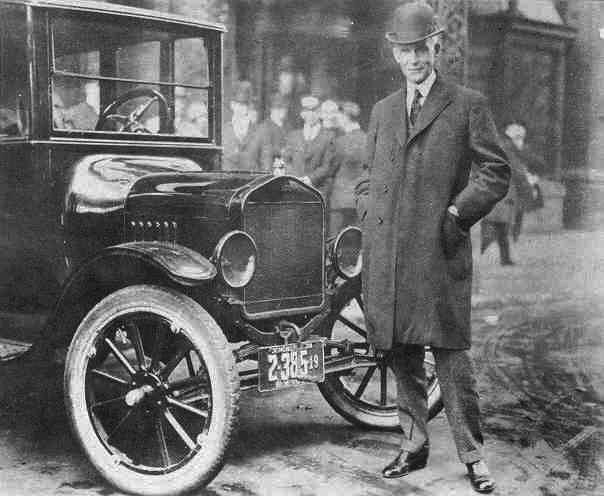
Henry Ford and
a Model T Ford
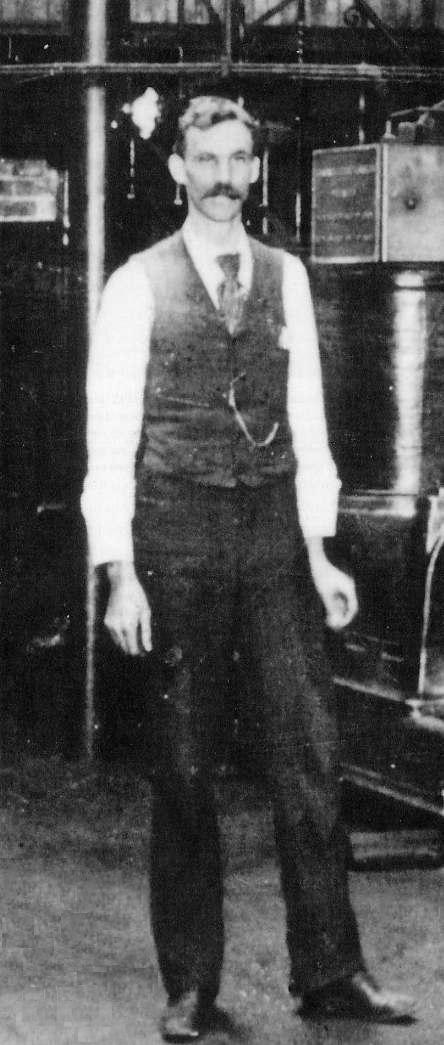
A young Henry Ford – chief
engineer at the Edison Illuminating Company, Detroit
Henry Ford Museum and Greenfield
Village (P.833.850)
Henry Ford's mock-up of his
new horseless buggy – 1907
(in 1908 he would begin
production of the Model T, which by 1927 he will have sold 15 million)
Henry Ford
Museum
Ford assembly line -
1914
Ford Motor Company, Stevens
Institute of Technology
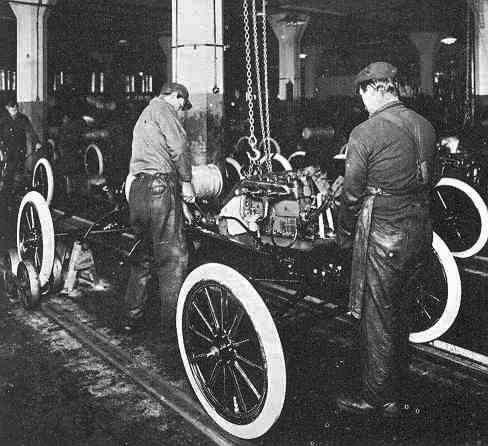
Ford assembly line -
1913
Ford Motor
Company
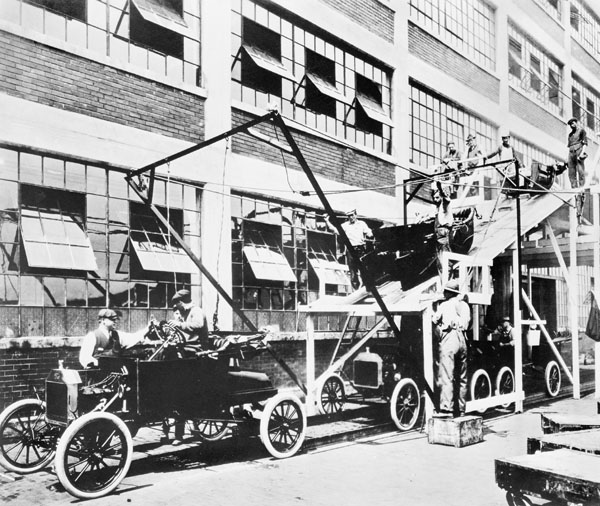
"1913 – Trying out the new
assembly line"
By an unknown photographer,
Detroit, Michigan, 1913
National Archives
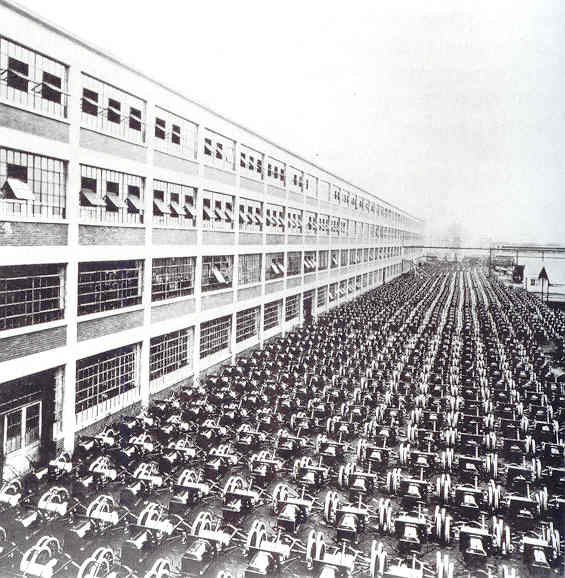
One day's production from
this Ford assembly plant: 1000 Model T bodies
Henry Ford Museum & Greenfield
Village
Model T Fords at the end
of the assembly line
Library of
Congress
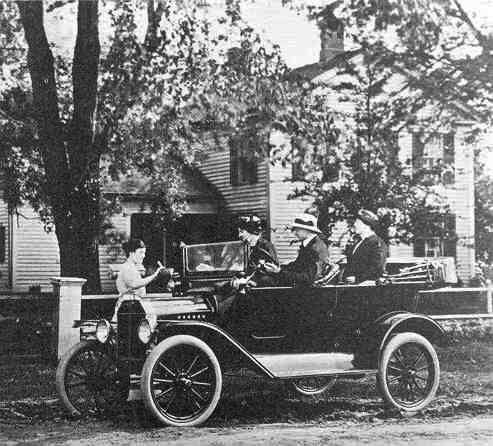
Model T Ford -
1913
(over 15 million Model T
Fords were produced by 1927)

|
A lost motorist along one
of America's rural roads
Automotive History Collection,
Detroit Public Library
A motorist in deep
trouble

|
|
The development of the airplane
One might easily suppose that the airplane would have come along much later than the automobile as a technological development since getting things off the ground would seem to be a much more difficult task than simply getting them to roll along the ground. But that was not the case. Airplane development seemed to parallel closely the development of the automobile. Balloons offered the first possibilities of human flight (back even in the late 1700s), and by the late 1800s airships or dirigibles with cabins slung below them and with electric-powered rotary blades to drive them looked as if they would be the route that air-flight would take. But they were soon challenged by heavier-than-air flying machines, the modern airplane. Of course there were a number of inventors across the Western world busily engaged in trying to create just such a flying machine, but the Wright brothers were clearly the real pioneers in the field.4 The brothers had carefully studied the dynamics of glider flight (over 200 models tested in a wind-tunnel that they created) and were able to conduct a number of very successful glider flights in 1902. They also built a small engine to power their plane. Finally on December 17, 1903 they were ready to test their new airplane. The first flight lasted only 12 seconds and flew a distance of only 120 feet (captured in the famous picture of this very first event). Later that day they reached a flight of 59 seconds covering 852 feet. Their success (only they, however, could have handled that very unstable first plane!) led them to develop further their design and in 1904 and 1905 they introduced newer and stronger models (the 1905 model flying 24 miles in just over 39 minutes). By 1906 inventors in other countries were taking an interest in the idea of airplane flight and a huge number of different models began to appear, especially in France where the interest seemed strongest (their flights at first paralleled only the Wrights' 1903 achievement rather than the Wrights' much more sophisticated 1906 success). In 1908 the Wright brothers traveled to France to demonstrate (to the amazement of the spectators) the possibilities of the airplane, and to encourage its development in Europe. In this they succeeded grandly, leading a British newspaper to offer a £1,000 reward, taken up by a French flyer who in 1909 was the first to fly across the English Channel. The military use of the airplane became immediately obvious and was used by the Italians in 1911 to bomb Muslim troops in Italy’s seizure of Libya from the Turkish Ottoman Sultan, in order to make it part of the new Italian Empire. Likewise, the Bulgarians used the airplane to survey and bomb Ottoman positions in the First Balkan War of 1912-1913. And of course it was used extensively in the Great War (World War One) that broke out the next year (1914) in Northern Europe. 4There
is still controversy about the claim of the German-turned-American
Whitehead (Weiskopf) of having in 1901 successfully conducted manned
flight in Connecticut, 2½ years before the Wright brothers.
|
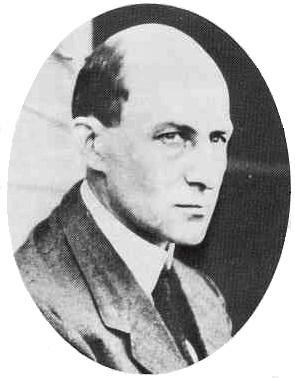
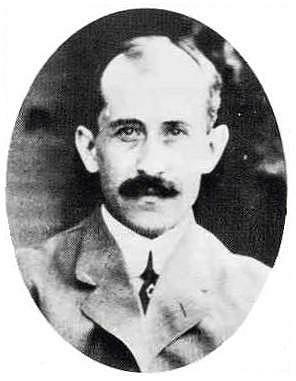
Wilbur (left) and Orville
Wright (right)
Library of Congress
Wilbur Wright pilots a glider
in North Carolina – 1902
Library of
Congress
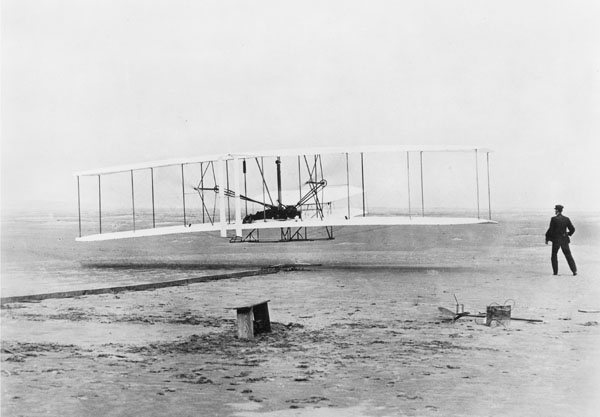
"Original Wright Brothers
1903 Aeroplane ("Kitty Hawk") in first flight, December 17, 1903,
at Kitty
Hawk, NC. Orville Wright at controls. Wilbur Wright at right
(First flight was 12 seconds)"
By Orville Wright and John
T. Daniels, December 17, 1903
National Archives
First flight at Kitty Hawk,
North Carolina, December 17, 1903
Glenn Curtiss flying the
"June Bug" – 1908
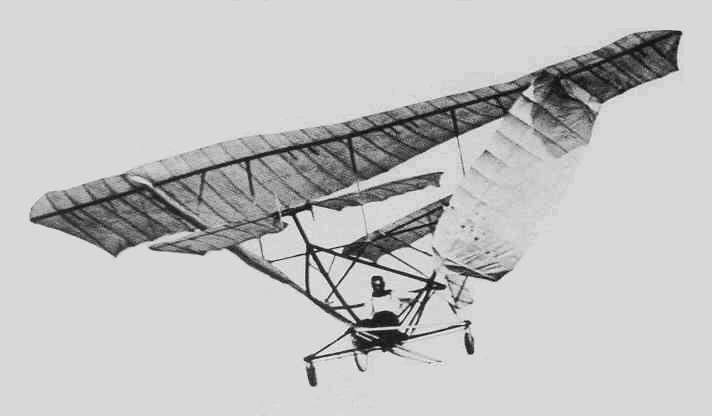
W. H. Martin flying the
"Martinette"
glider – 1909
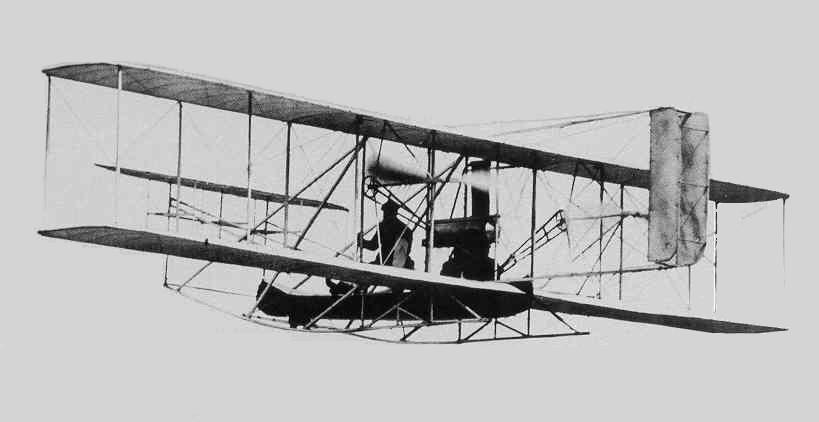
Wilbur Wright flying the
"Flyer" – 1909
The Wright brothers
demonstrating
their flying machine at the Tempelhof airstrip, Berlin – July 1909
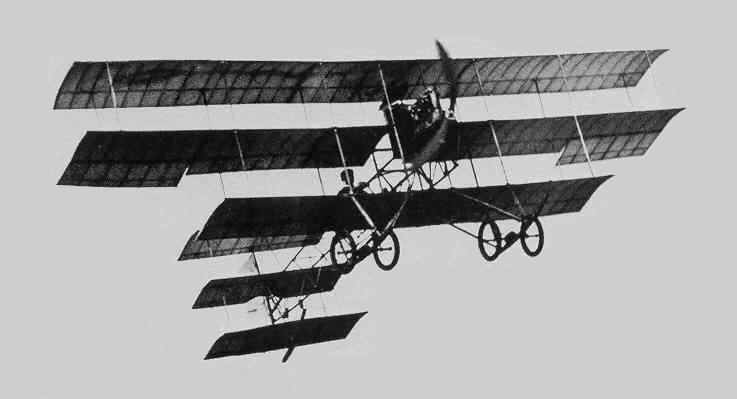
Clifton Hadley flying his
triplane – 1910
A British aviator demonstrates
his "aeroplane" before the White House – 1910
National Archives

|
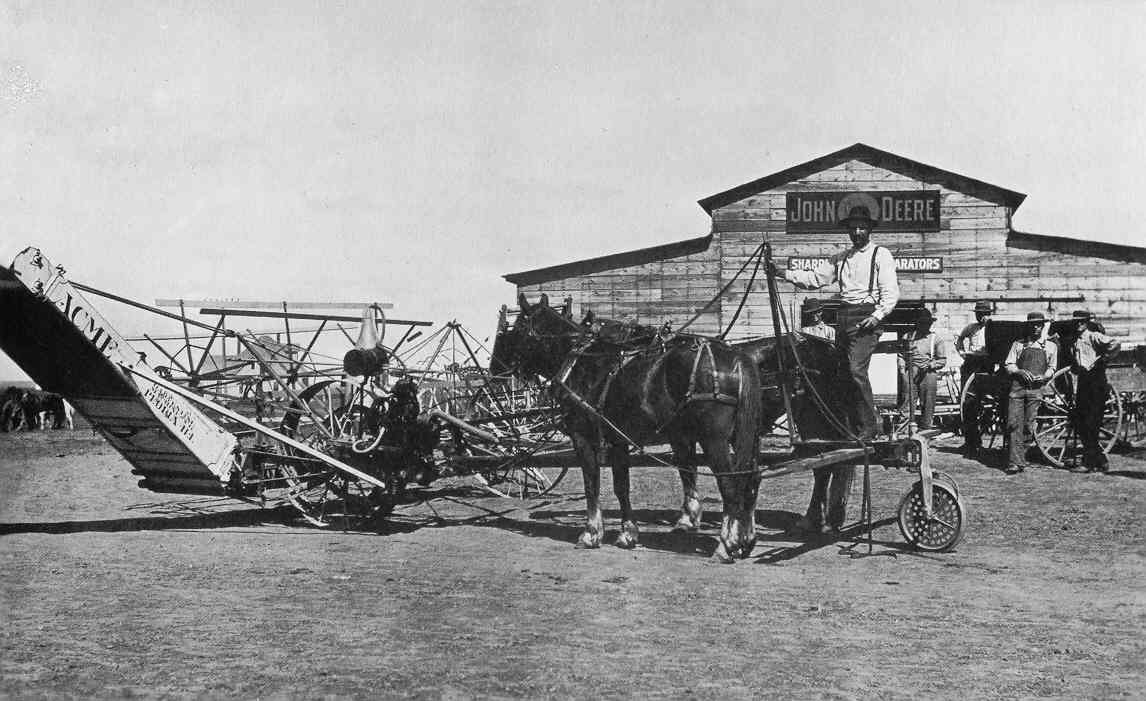
A John Deere header machine
for reaping wheat
Kansas State Historical
Society
Farmers looking over the
Nebraska wheat fields in the golden days of US farming – 1916


 Miles
H. Hodges
Miles
H. Hodges